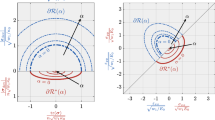Abstract
Atomistic techniques are used to study brittle fracture under opening mode and mixed mode loading conditions. The influence of the discreteness of the lattice and of the lattice-trapping effect on crack propagation is studied using an embedded atom potential for nickel to describe the crack tip. The recently developed FEAt (Finite Element-Atomistic) coupling scheme provides the atomistic core region with realistic boundary conditions. Several crystallographically distinct crack-tip configurations are studied and commonly reveal that brittle cracks under general mixed mode loading situations follow an energy criterion (G-criterion) rather than an opening-stress criterion (K l-criterion). However, if there are two competing failure modes, they seem to unload each other, which leads to an increase in lattice trapping. Blunted crack tips are studied in the last part of the paper and are compared to the atomically sharp cracks. Depending on the shape of the blunted crack tip, the observed failure modes differ significantly and can drastically disagree with what one would anticipate from a continuum mechanical analysis.
Similar content being viewed by others
References
R. Thomson, C. Hsieh, and V. Rana, J. Appl. Phys. 42, 3154 (1971).
J. E. Sinclair, Philos. Mag. 31, 647 (1975).
J. E. Sinclair and B. R. Lawn, Proc. R. Soc. London A 329, 83 (1972).
M. Mullins and M. A. Dokainish, Philos. Mag. A 46, 71 (1982).
S. Kohlhoff, P. Gumbsch, and H. F. Fischmeister, Philos. Mag. A 64, 851 (1991).
R. Thomson, S. J. Zhou, A. E. Carlsson, and V. K, Tewary, Phys. Rev. B 46, 10613 (1992).
K. S. Cheung and S. Yip, Phys. Rev. Lett. 65, 2804 (1990).
K. S. Cheung, A. S. Argon, and S. Yip, J. Appl. Phys. 69, 2088 (1991).
R. G. Hoagland, M. S. Daw, and J. P. Hirth, J. Mater. Res. 6, 2565 (1991).
S. J. Zhou, A. E. Carlsson, and R. Thomson, Phys. Rev. B 47, 7710 (1993).
S. J. Zhou, A. E. Carlsson, and R. Thomson, Phys. Rev. Lett. 72, 852 (1994).
F. F. Abraham, D. Brodbeck, R. A. Rafey, and W. E. Rudge, Phys. Rev. Lett. 73, 272 (1994).
G. C. Sih and H. Liebowitz, in Fracture, edited by H. Liebowitz (Academic Press, New York, 1968), Vol. 2, Chap. 2, pp. 67–190.
S. M. Foiles, M. I. Baskes, and M. S. Daw, Phys. Rev. B 33, 7983 (1986).
R. Thomson, in Solid State Physics, edited by H. Ehrenreich and D. Turnbull (Academic Press, New York 1986), Vol. 39, pp. 1–129.
J. E. Sinclair and M. W. Finnis, in Atomistics of Fracture, edited by R. M. Latanision and J. R. Pickens (Plenum Press, New York, 1983), pp. 1047–1053.
P. M. Anderson and R. Thomson, J. Appl. Phys. 76, 843 (1994).
J. R. Rice, J. Mech. Phys. Solids 40, 239 (1992).
G. Schoeck, Philos. Mag. A 63, 111 (1991).
J. R. Rice and G. E. Beltz, J. Mech. Phys. Solids 42, 333 (1994).
P. Gumbsch and G. E. Beltz, unpublished.
E. Kröner, Int. J. Solids Structures 3, 731 (1967).
M. S. Daw, S. M. Foiles, and M. I. Baskes, Mater. Sci. Rep. 9, 251 (1993).
A. T. Paxton, P. Gumbsch, and M. Methfessel, Philos. Mag. Lett. 63, 267 (1991).
M. I. Baskes and M. S. Daw, in Proceedings of the 4th International Conference on the Effect of Hydrogen on the Behavior of Materials (The Minerals, Metals and Materials Society, Warrendale, PA, 1990).
M. Mullins, Int. J. Fracture 24, 189 (1984).
J. R. Rice, in Fracture, edited by H. Liebowitz (Academic Press, New York, 1968), Vol. 2, Chap. 3, pp. 191–311.
Y. Sun and G. E. Beltz, J. Mech. Phys. Solids 42, 1905 (1994).
J. E. R. Fuller and R. Thomson, Fracture 1977 3, 387 (1977).
B. Lawn, Fracture of Brittle Solids, end ed. (University Press, Cambridge, UK, 1993).
A. Paskin, B. Massoumzadeh, K. Shukla, K. Sieradzki, and G. J. Dienes, Acta Metall. 33, 1987 (1985).
Author information
Authors and Affiliations
Rights and permissions
About this article
Cite this article
Gumbsch, P. An atomistic study of brittle fracture: Toward explicit failure criteria from atomistic modeling. Journal of Materials Research 10, 2897–2907 (1995). https://doi.org/10.1557/JMR.1995.2897
Received:
Accepted:
Published:
Issue Date:
DOI: https://doi.org/10.1557/JMR.1995.2897




